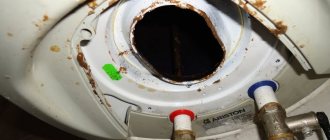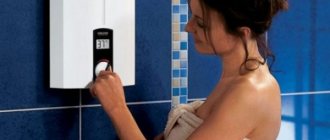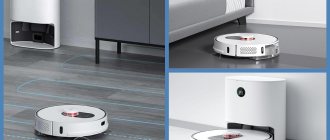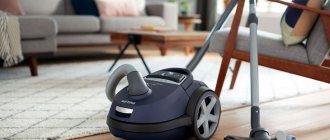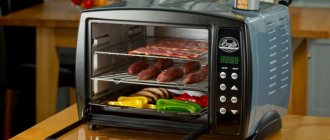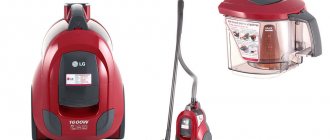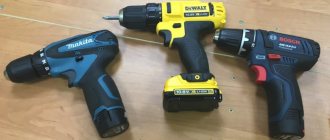Dry heating element in a water heater
A heating element is a tubular heating element. In the boiler, it heats cold water to the required temperature, which is set using the thermostat knob. When the required degrees are reached, the resistance in the temperature sensor changes and it cuts off the voltage supply to the heating element.
Heaters come in two types:
- "Wet". Comes in every shape and size. Outwardly, it usually resembles a standard boiler. The body of such an element is completely immersed in water.
- A dry heating element in a boiler does not come into contact with water. It is enclosed in a steatite (ceramic) or metal capsule and, together with it, is installed in the water heater.
Modern boiler models are increasingly equipped with a dry heating element due to its reliability, which is reflected in the warranty periods from manufacturers, which are higher than those of “wet” counterparts.
Best models: top 9
Boiler models with dry heating elements are always popular due to their reliability and safety in operation. To choose a boiler for yourself, you need to take into account its cost and size - the water heater must fit well into the room where it will be installed. Many boilers have the ability to install them on the floor or hang them on the wall using special fasteners. The location can be different: horizontal or vertical. The stainless steel tank of such brands as Atlantica, Termex and Zanussi is their advantage, as it extends the life of the devices.
This rating was compiled based on recommendations from consumers who bought boilers from these brands and have been using them for a long time. They assessed the functionality of this water heating equipment and learned their advantages/disadvantages.
Boiler Fagor CB ECO
- Price – from 12,300 rubles.
- Volume – 150 l.
- Country of origin : Spain.
- White color
- Weight – 43 kg.
This European manufacturer opens the rating of dry water heaters, providing its products with the appropriate certificates in accordance with international standards. According to customer reviews, this boiler is reliable for a large family. The price is affordable to purchase it for almost any home.
Fagor CB ECO water heater
| pros | Minuses |
| Design | Poor mounting anchors |
| Heats up quickly | |
| Maintains temperature for a long time |
Gorenje OGBS100SMV9
- Price – from 10,100 rubles.
- Volume – 100 l.
- Country of origin : Serbia.
- White color
- Management is electronic.
- Weight – 41 kg.
The Gorenje electric heater is reliable and high-quality equipment that will last for many years. A convenient interface allows you to set the desired heating temperature. Added functions: power indicator, heating temperature limitation, 4 degrees of protection - allows you to feel the convenience of having such equipment in your home.
Gorenje OGBS100SMV9 water heater
| pros | Minuses |
| Heats water very quickly up to 70 degrees | Not very clear controls |
| Compact | |
| Good quality |
Atlantic Vertigo
- Price – from 17,200 rubles.
- Volume – 80 l.
- Country of origin : France.
- White color
- Management is electronic.
- Weight – 33 kg.
- Dimensions (WxHxD) – 49x109x31 cm.
Soapstone heating elements are a development of the Atlantic brand. French developers were looking for ways to improve the performance of the equipment, and the invention of such a heating element allows this water heater to be used for a long time.
Atlantic Vertigo water heater
| pros | Minuses |
| Good quality, design | Bad anchors |
| Heats up quickly | |
| Convenient control |
Electrolux EWH 50 Formax DL
- Price – from 10,799 rubles.
- Volume – 50 l.
- Country of origin : China.
- White color
- Management is electronic.
- Weight – 23.1 kg.
- Dimensions (WxHxD) – 34.4×82.5×35 cm.
Electrolux electric heaters are quite compact, quickly heat water, saving time and electricity.
Electrolux EWH 50 Formax DL water heater
| pros | Minuses |
| The flat shape of the Electrolux boiler saves space and looks good | No fasteners included |
| Good thermal insulation, loses less than 10 degrees of heat in 12 hours when turned off | |
| 3 heating modes |
Willer Elegance IVB DR
- Price – from 11,345 rubles.
- Volume – 80 l.
- Country of origin : China.
- White color
- Control is mechanical.
- Weight – 18 kg.
- Dimensions (WxHxD) – 49.3×99.2×29 cm.
A special feature of this unit is a fundamentally new tubular heating element system, which allows for rapid heating of water. A protective magnesium anode ensures the safety of the tank from corrosion and extends its service life. A good device for little money.
Willer Elegance IVB DR water heater
| pros | Minuses |
| The controls are very clear | There is no sound signal about the end of heating |
| Heats water in a few minutes | |
| Tank coating – stainless steel |
Atlantic Steatite Cube VM 75 S4 CM
- Price – from 13,990 rub.
- Volume – 75 l.
- Country of origin : France.
- White color
- Control is mechanical.
- Weight – 27 kg.
- Dimensions (WxHxD) – 49×70.6×52.9 cm.
The French are very responsible in the production of various equipment and this water heater is no exception. European quality, reliability, stable operation of the boiler will please any buyer.
Atlantic Steatite Cube VM 75 S4 CM water heater
| pros | Minuses |
| Two operating modes (1.2 and 2.4 kW) | No built-in thermometer |
| Good thermal insulation | |
| Heats up quickly |
Ariston PRO ECO 50 V DRY HE
- Price – from 13,990 rub.
- Volume – 50 l.
- Country of origin : Italy.
- White color
- Management is electronic.
- Weight – 16 kg.
- Dimensions (WxHxD) – 45×52.8×47 cm.
Another European representative of reliability and compactness is the Ariston brand water heater.
Ariston PRO ECO 50 V DRY HE water heater
| pros | Minuses |
| Compact, lightweight, performs its functions well | Water cools quickly |
| Has accelerated heating | |
| There is an RCD |
Gorenje GBFU 80 E B6
- Price – from 10,711 rubles.
- Volume – 80 l.
- Country of origin : Serbia.
- White color
- Control is mechanical.
- Weight – 30 kg.
- Dimensions (WxHxD) – 45.4×81.6×46.1 cm.
Gorenje GBFU 80 E B6 water heater
| pros | Minuses |
| Horizontal installation | High power consumption |
| Convenient control mode | |
| Price quality |
Dry heating element device
The main reason for the increase in popularity of dry elements is the fight against water heater scale buildup. The device’s spiral is located in a sealed sealed tube and does not interact with water. The design also uses dense insulating material.
This technology does not completely solve scale problems. Plaque still forms around the flask over time, but it accumulates there much less than in models with a classic tubular heater.
A magnesium anode helps to cope with clogging and corrosion of the heating element, as well as the walls of the boiler. It is installed by the manufacturer in almost all models. The part is connected in such a way that the tank body and the heating element act as a cathode.
The anode has a negative charge and attracts microparticles to its body, that is, it takes the blow upon itself. Therefore, it is recommended to change the magnesium anode at least once every 3 years. You can do this yourself if you follow safety precautions.
On conventional heating elements, salt and calcium accumulate faster. It becomes covered with a “shell” and after a while burns out in it.
If a characteristic hissing sound is heard from the tank when heating water, this means that the heating element is already covered with a dense layer of scale and needs to be cleaned or replaced.
A dry heater can only be straight in shape. Because of this, it cannot be installed in a storage tank with a volume below 50 liters.
Nuances of choice
Choosing a water heater is a responsible process for each user, since it should last up to 10 years. It starts with determining the volume of the device.
To calculate the tank, you can contact specialists who will perform an accurate calculation of water use for hot water supply based on the volume of consumption for a specific family.
You can also use the advice and choose the following options for your household needs:
- 15-liter - enough for washing dishes, they are usually installed in the kitchen;
- 30-liter - suitable for a shower with one user;
- 50 liters, capable of providing water use via hot water supply for a family of 2 people;
- 80-liter, provides water use via hot water supply for a family of 3 people;
- 100 liters, guarantees supply for a family of 4 people.
Often for large families it is more efficient to install two devices instead of one, separately for the bathroom and kitchen.
When choosing a dry heating boiler, it is recommended to pay attention to the following parameters:
- The heating element is made of stainless steel or ceramics. Ceramic heaters cool much more slowly and do not create extraneous noise.
- The number of heating elements is better than two, since high-quality regulation is ensured and there is a power reserve in the event of failure of one of them.
- The control unit must have a thermostat, a temperature sensor, a power board and a display.
- Warranty conditions, during which the manufacturer undertakes to repair the water heater free of charge.
Types of dry heating elements
Equipment is classified according to several criteria. One of them is the presence of oil in the flasks. The lubricating fluid has high thermal conductivity and helps save energy for the user of the heating element.
In other models, there is air or sand between the spiral and the capsule. This heating element is cheaper and easier to maintain.
The devices also differ from each other in the required input voltage. Some elements operate on 380 volts, but the domestic home boiler uses a standardized version powered by 220 volts.
Another distinguishing parameter is power. It affects how long it takes for the water in the tank to warm up to the temperature set by the user. The average power of a dry heating element in a water heater is 1,200 watts. For wet elements this figure is usually higher - about two kilowatts.
Pros and cons of dry heating elements
The main advantage can be learned from the name of the device. Its spiral does not come into direct contact with water, so it will not quickly collapse even with poor quality liquid and regular use.
A dry heating element also differs from a wet one in that it is easier to maintain. It only replaces the spiral with terminal terminals for 220 volts. The capsule itself remains in the boiler body, which allows repairs to be made without draining the water from the tank. This kind of work can be done well on your own even without proper qualifications. All you need is a high-quality tool, and step-by-step instructions can be found in the training videos.
It is not recommended to drain water from the tank unless absolutely necessary. When its body interacts with oxygen from the inside, the risk of corrosion spreading increases significantly. This may cause a leak. A small crack or hole can still be repaired, but if a large area is damaged, the boiler will have to be replaced.
Another advantage of a dry element is safety. Due to the fact that it is placed in a special capsule, there is no risk that the energized spiral will touch the conductive body and a so-called “breakthrough to the body” will appear. If a person touches a boiler with a “broken” device, he may be electrocuted.
These devices are also compact. Therefore, some manufacturers place 2 elements in the tank body at once, which speeds up the heating process.
The key disadvantage of a dry tubular electric heater is its high price. A classic tubular element can be purchased at 2 times cheaper. Also, the heater power in the capsule will always be less.
Which heating element design to choose?
The answer to the question: “Is it better to use a dry or wet heating element?” depends on the conditions in which the product will be used. Classic heaters are easier to choose for your boiler model, as they are universal. They have a wide range on the market; parts of this type quickly bring water to the required temperature.
But such heaters have low resistance to scale, although they are also installed together with a magnesium anode. A wet heating element is demanding on water quality; it will have to be changed more often, and to do this you will need to drain all the liquid from the tank.
Therefore, a dry element should be chosen by those who use a well or live in a region where there are problems with increased water hardness.
Tips for caring for a water heater with a dry heating element
Despite the fact that a dry heating element prevents the formation of scale and corrosion better than a classic heating element, it will still have to be serviced. The manufacturer recommends cleaning the flask in which the spiral is located, and the inside of the tank itself, every 2-3 years. This procedure will help extend the life of the element.
If the water in the container stops heating, then you can check the heating element yourself. For this you will need an ohmmeter.
Test leads must be attached to the two terminals to which power is supplied. The resistance of the part should appear on the device (the exact figure can be found in its data sheet). If the display shows zero, this means that the coil is broken and the tubular electric heater must be replaced.
To reduce calcium deposits and deposits in the tank, it is recommended to install a filter in the water supply system. It is important to change its cartridges in a timely manner.
Boilers with a stainless inner bulb must be grounded. Otherwise, due to stray currents, its body may leak. This phenomenon is also often observed in ungrounded autonomous heating systems.
Water heaters with dry and wet heating elements have a big difference in price. But the service life of devices of the first type is longer and easier to maintain. Thus, the discrepancy in cost can be compensated for by savings on maintenance costs.
How to choose
When purchasing a device, the following criteria are taken into account:
- Case dimensions. When installing in the bathroom of a typical apartment, preference is given to horizontal devices. They are mounted under the ceiling, which helps to properly distribute the space of the room.
- Device functionality. You shouldn't give up modern technology. Boilers with an electronic control unit and display are equipped with self-diagnosis and cleaning functions.
- Manufacturer reliability. Devices from trusted brands last longer than devices from dubious brands. When choosing a water heater, user reviews are taken into account.

